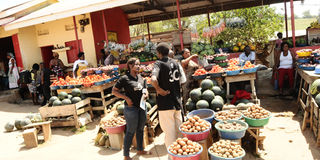Prime
Rising interest rates slow borrowing

Traders in a market. Kampala City Traders Association highlighted that the high interest rates were leading to lower levels of production and leading to higher prices in the economy. PHOTO/ JOSEPH KIGGUNDU
What you need to know:
- According to the BoU figures, in the quarter to June 22, loan applications and approvals had dropped significantly from the previous quarter.
- Notably, only just 52 percent of loan applications were approved in the quarter to June 2022. This is a decline from 54 percent in the quarter to March 2022 and from 56 percent in the quarter to December 2022.
On October 6, after the October Monetary Policy Meeting, Deputy Governor, Martin Atingi-Ego said that the private sector uptake in credit was slowing down.
“Indeed, growth in private sector credit and monetary aggregates had moderated, signaling the eventual impact on aggregate demand,” the Atingi-Ego’s statement reads. In this, the deputy Governor is indicating that the actions to increase the Central Bank Rate (CBR) since June 2022, for the fourth consecutive time, the loan approvals and application to commercial banks have slowed down.
The BoU’s biggest concern is the core inflation (that excludes food, energy and fuel) being above the 5 percent. At the end of October, core inflation was at a 10-year high of 8.1 percent. The swift central bank response means that banks have to equally respond and raise interest rates since they have received a signal.
Slowdown
“Private Sector Credit (PSC) growth remains weak owing to weak aggregate demand. The weak aggregate demand is being amplified by weakening balance sheets of both households and firms as the rising inflation takes a toll on the cash flows of both households and business sectors, inducing higher risk aversion of the lenders,” reads the August 2022 Monetary Policy Report.
The report indicates that between June-2021 and June 2022, private sector credit growth was still under 10 percent annually. Private sector credit had started picking up as the economy was reopened in January but the inflationary pressures from March and the consequent increment in the CBR has slowed that down again.
According to the BoU figures, in the quarter to June 22, loan applications and approvals had dropped significantly from the previous quarter. Notably, only just 52 percent of loan applications were approved in the quarter to June 2022. This is a decline from 54 percent in the quarter to March 2022 and from 56 percent in the quarter to December 2022.
The BoU projection is that loan approvals and applications will likely reduce further, which is the aim of raising the CBR in order to suppress demand.
From commercial banks that have released half-year results to June 30, 2022 the picture is unclear on the loans slowing down. In the first half of 2022, Bank of Baroda’s loan book grew by 20 percent to Shs1 trillion, Stanbic Banks’ loan-book grew by a mild 2 percent to Shs3.8 trillion, whereas dfcu’s loan book reduced by 16 percent to Shs1.4 trillion.
This does not tell the real story of the economy but indicates how banks have started adjusting their lending. Bank of Baroda’s loans can’t, however, be compared to that of Stanbic and dfcu. Rarely risk averse, in the last three years, the highest Non-performing Loan (NPL) Bank of Baroda has registered is just 1.4 percent (2019) of its loans.
In the last three years, Baroda’s NPLs have averaged 0.8 percent, the lowest of all commercial banks with the exception of Citi Bank. For Stanbic and Dfcu, it is clear that they deal with customers that are affected by the shocks to the economy, which explains their slow-down in lending.
Temporary but bitter medicine
In trying to tame inflation by raising the CBR and banks subsequently increasing their interest rates, it will likely hurt the prospects for economic growth. For businesses that rely on credit from commercial banks, there is already a cry for help as those with floating interest rates feel the pinch. Their interest rates are rising whereas their businesses are not generating more revenue than before due to suppressed demand. These concerns about the rising interest rates have been raised by the Kampala City Traders Association (KACITA) and the Uganda Manufacturers Association (UMA).
In a petition to Parliament on October 4, 2022, KACITA highlighted that the high interest rates were leading to lower levels of production and leading to higher prices in the economy. In their petition, they indicate that the “higher CBR means higher interest on bank loans to reduce the borrowing appetite by business people.”
Despite these concerns, the BoU maintains that the economy requires this action (increasing the CBR) to tame the runaway inflation.
“Curing the economy of inflation becomes urgent for securing people’s survival and well-being. Unfortunately, restoring inflation to low and stable levels involves taking medicine with some temporary side effects,” Atingi-Ego the BoU Deputy Governor recently wrote in the Daily Monitor.
But is not yet clear how severe these side effects will be considering there are already economic casualties due to the rising interest rates.




